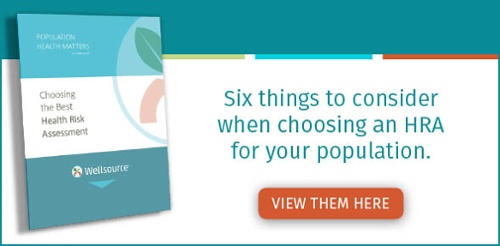Any time an organization implements a new program it’s likely that continuation of the program depends on a demonstrably positive Return on Investment (ROI). Within the health and wellness space those returns will be both monetary and less tangible. The less tangible returns—the Value on Investment (VOI)—typically measure success metrics that factor in whether the program has had a positive or negative impact on the population as a whole; things like positive trends in population health or the ease with which at-risk populations are being identified and provided with new resources. These two aspects are carefully considered when determining the overall success and effectiveness of an HRA.
When it comes to health risk assessments (HRAs) and wellness programs, not only do organizations want to show that their investment in their wellness program was sound, but they also need to demonstrate that the HRA itself played an imperative part in making that determination. The HRA is the tool that gathers the data required to show success and it’s therefore a critical tool in delivering ROI and VOI metrics for your wellness program.
In this post, we’re going to look at how a reliable, trustworthy HRA can help population health professionals demonstrate a positive ROI and VOI for wellness programs.
The Return and Value on Investment of HRAs (ROI and VOI)
For the most part, the ROI of any program or initiative relates directly back to finances. If an organization spends a certain amount of money on a project, they want to know that in the end they at least covered their costs. Depending on the scope of the project’s implementation and goals, organizations may look to measure return on wellness initiatives after a year or more.
Why?
Because it takes time for individuals to engage with the assessment, absorb their results, schedule appointments with their care providers (if necessary), and create their own plans for enacting personal change. If an individual learns they’re at risk for cardiovascular disease, for example, they aren’t simply going to flip a switch and immediately have improved health. They’re going to need to change their diet and exercise regime while consulting with their care team. Changes to a population’s health aren’t going to happen overnight, and in fact sustained shifts in lifestyle and habits will take much longer.
When reviewing the financial aspect of the ROI of an HRA some things that are routinely considered are:
- Lowered medical claims costs
- Lowered employee insurance costs
- Lowered disability claims
- Lowered Workers’ Compensation claims
- Decreased employee absenteeism
Value on Investment is a different kind of metric. The value of something like an HRA may not relate directly back to finances, but instead—as mentioned earlier—to the more intangible aspects of the program’s results. These include things like:
- Year-over-year population health improvements
- Year-over-year increases in initiative engagement
- Implementation and success of targeted at-risk population initiatives
- Identification of at-risk populations
VOI also includes things that are so intangible that it can be difficult to figure out how to measure them without an HRA, such as the cost-savings of avoiding ailments or illnesses. The only way to measure the cost-savings of something that didn’t materialize is to know that it could have happened and work backwards… an HRA in a nutshell!
Measuring the effectiveness of those intangible pieces without having an HRA in place to identify trends in population health would be difficult.
Cutting Down on Population Health Costs
HRAs are not a diagnostic tool, but they can help individuals take control of their health, which could lead to a reduction in population health costs. Costs are reduced in several ways, including a decrease in insurance claims and an increase in early detection and intervention. It’s much easier to treat a disease early than in its late stages. This in turn increases the chances of a positive prognosis and less down-time for treatments.
For example, if someone becomes aware that they may be at an increased risk for cardiovascular disease they’ll hopefully take the appropriate steps to mitigate that risk before their health deteriorates. These steps may include an initial investment on their part in the beginning—a gym membership, visits to their primary care physician or a specialist for a physical, or a trip to the nutritionist to get their diet in check—but the cost savings of avoiding a trip to the emergency room or, even worse, emergency surgery will be worth it.
Decreasing Disability and Workers’ Compensation Claims
Similarly, when individuals are aware of their health risks and are actively monitoring and improving their health, they’re less likely to file for disability and Workers’ Compensation claims. That’s because the types of injuries or ailments that may necessitate these claims could be mitigated with earlier intervention or more awareness. Using our example above, improved cardiovascular health won’t necessarily prevent all on-site work accidents, but being in better physical shape can prevent injuries and ailments that may arise during the usual course of business.
HRAs can also create a positive VOI in areas outside of physical health. Individuals who are struggling with high-stress or poor mental health may also benefit from a risk assessment that helps them self-identify and then provides resources and interventions. For example, if an individual can effectively manage their stress or anxiety—either by implementing tips on their own or seeking professional help—they could avoid situations where their stress negatively affects their physical health.
At the end of the day, it’s impossible to put a dollar amount on good health—it’s priceless, after all. However, resources, including budgets, aren’t limitless. Putting efficient and effective systems in place can ensure that the wellness programs and initiatives plan and implement help you meet—and exceed—your population health goals. A reliable HRA is a critical component of this process since it acts as both the starting point of wellness improvement initiatives and as a vehicle for gathering the data required to make determinations about program success.
If you’re ready to take the next step and choose an HRA but aren’t sure which one is right for your organization, download our helpful checklist: Choosing the Best Health Risk Assessment.








